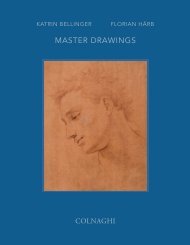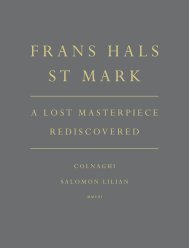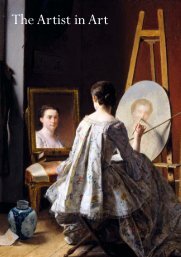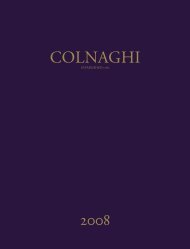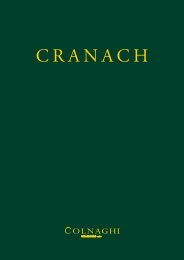2007 Catalogue - Colnaghi
2007 Catalogue - Colnaghi
2007 Catalogue - Colnaghi
Create successful ePaper yourself
Turn your PDF publications into a flip-book with our unique Google optimized e-Paper software.
Provenance: Commissioned by Elector-Palatine,<br />
Johann Wilhelm, Düsseldorf; Mannheim, Kunsthalle,<br />
1780, no. 295; Munich, Hogarten Galerie, 1805, no.<br />
924; with Galerie Schleissheim, Munich, 1810; Alte<br />
pinakothek, Munich, 1836 ; deaccessioned policy from<br />
the Alte Pinakothek in 1937; with John Mitchell,<br />
London, 1937; Private collection, England, 1937;<br />
George L. Lazarus, by 1956.<br />
Literature: C. Hofstede de Groot, <strong>Catalogue</strong> of Dutch<br />
Painters, Teaneck and Cambridge, 1928, vol. X, no.<br />
16; M. H. Grant, Rachel Ruysch, Leigh-on-Sea, 1956,<br />
p. 30, no. 58; P. Mitchell, European Flower Painters,<br />
London, p. 203, pl. 205; Francesco Solinas, ed. Fiori:<br />
Cinque secoli di pittura floreale, exhibition catalogue,<br />
Rome, 2004, p. 299, illustrated; To be included in the<br />
forthcoming catalogue raisonné by Marianne Berardi.<br />
Exhibited: Royal Academy, London, Dutch Painters,<br />
winter 1952/53, no. 553; John Mitchell & Son,<br />
Inspiration of Nature, 1976; Dulwich Picture Gallery,<br />
London, Dutch Flower Painting 1600-1750, 1996,<br />
no. 27; Biella, Italy, Fiori: Cinque secoli di pittura<br />
floreale, 2004.<br />
Ruysch’s composition of curves and smooth shapes is<br />
one of elegance, sophistication and femininity.<br />
Abundance, exemplified by these elegant lines and<br />
rounded forms, had become the purpose of flower stilllife<br />
by the turn of the eighteenth century. The vanitas<br />
theme that was so popular in early examples of the<br />
genre had receded and, with the works of Ruysch and<br />
her contemporary Jan van Huysum an interest in the<br />
decorative overtook the earlier emphasis on moralizing<br />
iconography. Ruysch increasingly favoured diagonals<br />
and often oriented her compositions around them, as<br />
she has in this painting of 1709 and Flowers in a Vase<br />
from the same period (National Gallery, London). The<br />
tulip at the top of the bouquet that inclines towards<br />
the right is balanced by the weight of the peony at the<br />
lower left, while the broken stem of the carnation<br />
extends the line of the tulip to form an elegant S shape,<br />
in almost perfect accordance with Hogarth's later 'line<br />
of beauty'.<br />
08<br />
Rachel Ruysch<br />
(The Hague 1664 – 1750 Amsterdam)<br />
Roses, Tulips and other Flowers in a Glass Vase on a Stone Ledge<br />
Signed and dated lower right: Rachel Ruysch 1709<br />
Oil on canvas<br />
30 3 /4 x 25 1 /4 in. (78 x 64 cm.)<br />
34<br />
Rachel Ruysch was a favourite among contemporary<br />
poets. Hieronymus Sweerts dedicated a poem to her<br />
in which he declared that:<br />
‘Zeuxis' illustrious progeny<br />
will crown your youthful person<br />
as their Flower Goddess<br />
for your beautifully variegated festoons, bouquets,<br />
and wreaths, painted with a brilliance<br />
that few can match.<br />
If Mistress Oosterwyk<br />
sat here in bridal splendor,<br />
you would outshine her.<br />
De Heem would rise from his grave,<br />
with van der Ast and van Aelst, upon whose works<br />
the world has showered its praise.’<br />
(Alle de gedichten, Amsterdam, 1697)<br />
No less than eleven contemporary poets paid tribute<br />
to her after her death in an anthology published in<br />
1750 devoted to “de uitmuntende schilderesse<br />
mejuffrouwe Rachel Ruysch” (the excellent painter<br />
Miss Rachel Ruysch). More recent admirers have<br />
described her as “the small snowy dome which crowns<br />
the Everest of this particular art” and advised the<br />
potential buyer that “with Rachel Ruysch there are no<br />
poor pieces, and a man might with perfect safety send<br />
in his bid for a "lot" which he had never seen”. 1<br />
Rachel Ruysch was born into an artistic family in<br />
The Hague in 1664. Her father was the renowned<br />
anatomist and botanist, Frederick Ruysch (1638 -<br />
1731), and her mother was the daughter of the<br />
architect Pieter Post. She became a pupil of Willem<br />
van Aelst in 1679, at the age of fifteen, and remained<br />
in his studio until the painter's death in 1683. In 1693<br />
she married the portrait painter Juriaen Pool, with<br />
whom she had ten children. In 1709 the family moved<br />
to The Hague where both entered the city's St. Luke's<br />
Guild. From 1708 to 1713 both Ruysch and Pool<br />
served in Düsseldorf as court painters to the Elector<br />
Palatine, Johann Wilhelm. Ruysch’s Fruit and Flowers<br />
in a Forest (Städtische Kunstsammlungen, Chemnitz,<br />
Germany) was commissioned by the Elector and hung<br />
in his bedroom, together with Vase of Flowers (now in<br />
(Bayerische Staatsgemäldesammlungen, Munich).



